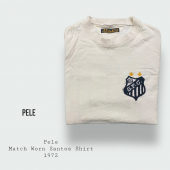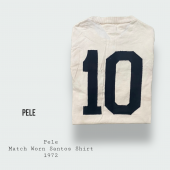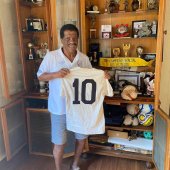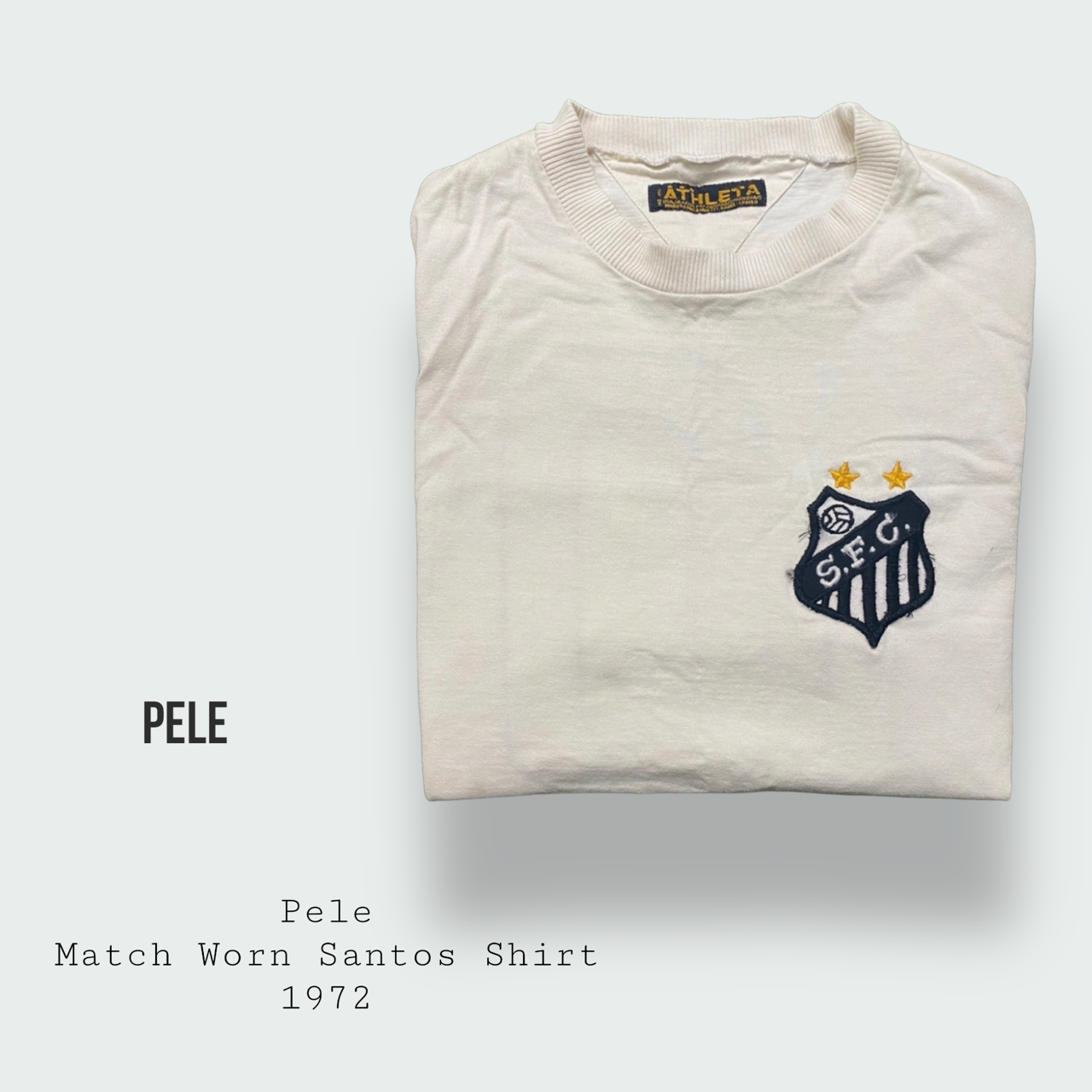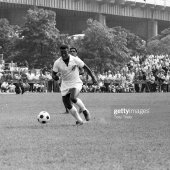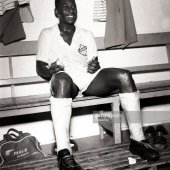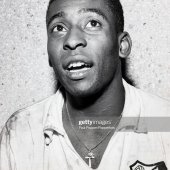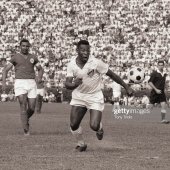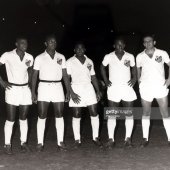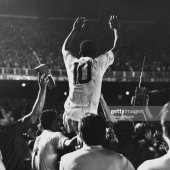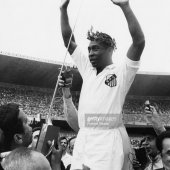Pele Match Worn Santos Shirt – 1972
Incredibly rare Pele match worn Santos shirt
Beautiful and historic worn shirt from former Santos player and possibly the greatest footballer of all time
Shirt worn by Pele for Santos during the 1972 season
Shirt comes from the private collection of former team mate and close friend Ze Maria ( please see picture attached of Ze Maria holding this shirt )
Also comes with a signed letter of authenticity from Ze Maria confirming he obtained the shirt and is worn by Pele
Amazing , ultra rare and historic shirt from possibly the greatest player of all time
Musuem example item
Regarded as one of the greatest players of all time and labelled "the greatest" by FIFA, he was among the most successful and popular sports figures of the 20th century. In 1999 he was named Athlete of the Century by the International Olympic Committee and was included in the Time list of the 100 most important people of the 20th century. In 2000, Pelé was voted World Player of the Century by the International Federation of Football History & Statistics (IFFHS), and was one of the two joint winners of the FIFA Player of the Century. His 1,279 goals in 1,363 games, which included friendlies, is recognised as a Guinness World Record.
Pelé began playing for Santos at age 15 and the Brazil national team at 16. During his international career, he won three FIFA World Cups: 1958, 1962 and 1970, the only player to do so. Pelé is the all-time leading goalscorer for Brazil with 77 goals in 92 games. At club level he is Santos' all-time top goalscorer with 643 goals from 659 games. In a golden era for Santos, he led the club to the 1962 and 1963 Copa Libertadores, and to the 1962 and 1963 Intercontinental Cup. Credited with connecting the phrase "The Beautiful Game" with football, Pelé's "electrifying play and penchant for spectacular goals" made him a star around the world, and his teams toured internationally in order to take full advantage of his popularity. During his playing days, Pelé was for a period the best-paid athlete in the world. Since retiring in 1977, Pelé has been a worldwide ambassador for football and has made many acting and commercial ventures. In 2010, he was named the Honorary President of the New York Cosmos.
Averaging almost a goal per game throughout his career, Pelé was adept at striking the ball with either foot in addition to anticipating his opponents' movements on the field. While predominantly a striker, he could also drop deep and take on a playmaking role, providing assists with his vision and passing ability, and he would also use his dribbling skills to go past opponents. In Brazil, he is hailed as a national hero for his accomplishments in football and for his outspoken support of policies that improve the social conditions of the poor. His emergence at the 1958 World Cup where he became the first black global sporting star was a source of inspiration. Throughout his career and in his retirement, Pelé received several individual and team awards for his performance in the field, his record-breaking achievements, and legacy in the sport.
SANTOS
In 1956, de Brito took Pelé to Santos, an industrial and port city located near São Paulo, to try out for professional club Santos FC, telling the directors at Santos that the 15-year-old would be "the greatest football player in the world. Pelé impressed Santos coach Lula during his trial at the Estádio Vila Belmiro, and he signed a professional contract with the club in June 1956. Pelé was highly promoted in the local media as a future superstar. He made his senior team debut on 7 September 1956 at the age of 15 against Corinthians Santo Andre and had an impressive performance in a 7–1 victory, scoring the first goal in his prolific career during the match.
When the 1957 season started, Pelé was given a starting place in the first team and, at the age of 16, became the top scorer in the league. Ten months after signing professionally, the teenager was called up to the Brazil national team. After the 1958 and the 1962 World Cup, wealthy European clubs, such as Real Madrid, Juventus and Manchester United tried to sign him in vain; in 1958 Inter Milan even managed to get him a regular contract, but Angelo Moratti was forced to tear the contract up at the request of Santos' chairman following a revolt by Santos' Brazilian fans. In 1961 the government of Brazil under President Jânio Quadros declared Pelé an "official national treasure" to prevent him from being transferred out of the country.
Pelé won his first major title with Santos in 1958 as the team won the Campeonato Paulista; Pelé would finish the tournament as top scorer with 58 goals, a record that stands today. A year later, he would help the team earn their first victory in the Torneio Rio-São Paulo with a 3–0 over Vasco da Gama. However, Santos was unable to retain the Paulista title. In 1960, Pelé scored 33 goals to help his team regain the Campeonato Paulista trophy but lost out on the Rio-São Paulo tournament after finishing in 8th place. In the 1960 season, Pelé scored 47 goals and helped Santos regain the Campeonato Paulista. The club went on to win the Taça Brasil that same year, beating Bahia in the finals; Pelé finished as top scorer of the tournament with 9 goals. The victory allowed Santos to participate in the Copa Libertadores, the most prestigious club tournament in the Western hemisphere.
Santos's most successful Copa Libertadores season started in 1962; the team was seeded in Group One alongside Cerro Porteño and Deportivo Municipal Bolivia, winning every match of their group but one (a 1–1 away tie versus Cerro). Santos defeated Universidad Católica in the semi-finals and met defending champions Peñarol in the finals. Pelé scored twice in the playoff match to secure the first title for a Brazilian club. Pelé finished as the second top scorer of the competition with four goals. That same year, Santos would successfully defend the Campeonato Paulista (with 37 goals from Pelé) and the Taça Brasil (Pelé scoring four goals in the final series against Botafogo). Santos would also win the 1962 Intercontinental Cup against Benfica. Wearing his number 10 shirt, Pelé produced one of the best performances of his career, scoring a hat-trick in Lisbon as Santos won 5–2.
As the defending champions, Santos qualified automatically to the semi-final stage of the 1963 Copa Libertadores. The ballet blanco, the nickname given to Santos for Pelé, managed to retain the title after victories over Botafogo and Boca Juniors. Pelé helped Santos overcome a Botafogo team that featured Brazilian greats such as Garrincha and Jairzinho with a last-minute goal in the first leg of the semi-finals which made it 1–1. In the second leg, Pelé scored a hat-trick in the Estádio do Maracanã as Santos won, 0–4, in the second leg. Santos started the final series by winning, 3–2, in the first leg and defeating Boca Juniors 1–2, in La Bombonera. It was a rare feat in official competitions, with another goal from Pelé. Santos became the first (and to date the only) Brazilian team to lift the Copa Libertadores in Argentine soil. Pelé finished the tournament with 5 goals. Santos lost the Campeonato Paulista after finishing in third place but went on to win the Rio-São Paulo tournament after a 0–3 win over Flamengo in the final, with Pelé scoring one goal. Pelé would also help Santos retain the Intercontinental Cup and the Taça Brasil against AC Milan and Bahia respectively.
In the 1964 Copa Libertadores, Santos were beaten in both legs of the semi-finals by Independiente. The club won the Campeonato Paulista, with Pelé netting 34 goals. Santos also shared the Rio-São Paulo title with Botafogo and won the Taça Brasil for the fourth consecutive year. In the 1965 Copa Libertadores, Santos reached the semi-finals and met Peñarol in a rematch of the 1962 final. After two matches, a playoff was needed to break the tie.
Unlike 1962, Peñarol came out on top and eliminated Santos 2–1. Pelé would, however, finish as the topscorer of the tournament with eight goals. This proved to be the start of a decline as Santos failed to retain the Torneio Rio-São Paulo. In 1966, Pelé and Santos also failed to retain the Taça Brasil as Pelé's goals were not enough to prevent a 9–4 defeat by Cruzeiro (led by Tostão) in the final series. The club did, however, win the Campeonato Paulista in 1967, 1968 and 1969. On 19 November 1969, Pelé scored his 1,000th goal in all competitions, in what was a highly anticipated moment in Brazil. The goal, dubbed O Milésimo (The Thousandth), occurred in a match against Vasco da Gama, when Pelé scored from a penalty kick, at the Maracanã Stadium.
Pelé states that his most memorable goal was scored at Rua Javari stadium on a Campeonato Paulista match against São Paulo rival Clube Atlético Juventus on 2 August 1959. As there is no video footage of this match, Pelé asked that a computer animation be made of this specific goal. In March 1961, Pelé scored the gol de placa (goal worthy of a plaque), against Fluminense at the Maracanã. Pelé received the ball on the edge of his own penalty area, and ran the length of the field, eluding opposition players with feints, before striking the ball beyond the goalkeeper. A plaque was commissioned with a dedication to "the most beautiful goal in the history of the Maracanã".
In 1969, the two factions involved in the Nigerian Civil War agreed to a 48-hour ceasefire so they could watch Pelé play an exhibition game in Lagos. Santos ended up playing to a 2–2 draw with Lagos side Stationary Stores FC and Pelé scored his team's goals. The civil war went on for one more year after this game. During his time at Santos, Pelé played alongside many gifted players, including Zito, Pepe, and Coutinho; the latter partnered him in numerous one-two plays, attacks, and goals. Pelé's 643 goals for Santos was the most goals scored for a single club until it was surpassed by Lionel Messi of Barcelona in December 2020.

